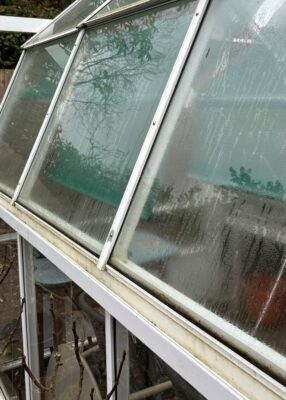
Clear autumn leaves from gutters as they start to fall. Prevent downpipes from clogging by putting a pan scourer in the hole at the top, then clearing the debris as it backs up, from time to time. Collect rainwater in a waterbutt, when it is full, water at the base of fences under the eaves of your house where it is dry – anywhere where there is a rain shadow.
To force mint for winter, take a pot of mint, cut back the foliage so it is 5cm or so above the compost. Put a layer of multipurpose or multipurpose with added John Innes compost (peat free) in the base of a large seed tray to about 1/3 its depth, tap the tray two or three times firmly on the potting bench surface to settle the compost beforehand. Knock the root ball from the pot, take an old saw or kitchen knife and carefully saw the root ball in half, across the centre from top to bottom, then remove about 2.5cm from the base. Tease out the roots of one half and repot and label ready for next year; shake the compost from the other half of the rootball, and cut lengths of thicker roots 10 -20cm long and lay them on the surface of the compost, leaving 2-3 cm between each one, then cover them with a layer of compost, then take them to the greenhouse and give the compost a good soaking with tepid water. Label the tray with the name and date. Do this from the middle to the end of the month in an unheated greenhouse and you will have fresh mint for Christmas. Growth can be hastened by putting the tray in a propagator at 18-20C.
Overwinter chilli plants to keep them for the following year by trimming back the side branches to 5cm from the main stem, putting the pots on a heated mat at around 15C and covering with fleece, which can be removed on warm days. Water occasionally to prevent the roots from dying but don’t overwater or the roots will rot. Not all chilli’s over winter, C. bacchatum and C. pubescens are the most reliable.
Sow sweet peas in a cool greenhouse, first soften the seed coat by putting the seeds between two layers of kitchen towel on an plate. Dampen the towel, drain off excess water, sow those that start to swell or sprout after about 48 hours. Leave the remainder a little longer; those that don’t swell and germinate can be composted. Sow them individually into ‘Root Trainers’ or 9cm (3in) pots of seed compost or put five to seven seeds to a 13cm (5in) pot, spaced 2-3cm (¾-1¼in) apart. Cover them with 1cm (½in) of compost. Water in gently, cover the pots with clear polythene then put them in a propagator at about 15°C (59°F). Remove the covering once they have germinated and overwinter the young plants in a cold frame or unheated greenhouse. If not sown individually, transplant single seedlings into 9cm (3in) pots once they are about 3.5 cm (1½in) tall.
Avoid wetting the leaves when watering greenhouse plants to avoid problems with fungal diseases. Watering in the morning means that accidental splashes will have dried out by nighttime.
Remove any dead diseased or dying leaves from greenhouse plants regularly, before problems spread.
Happy gardening. Matt


